Milviz Cessna 310 User Manual
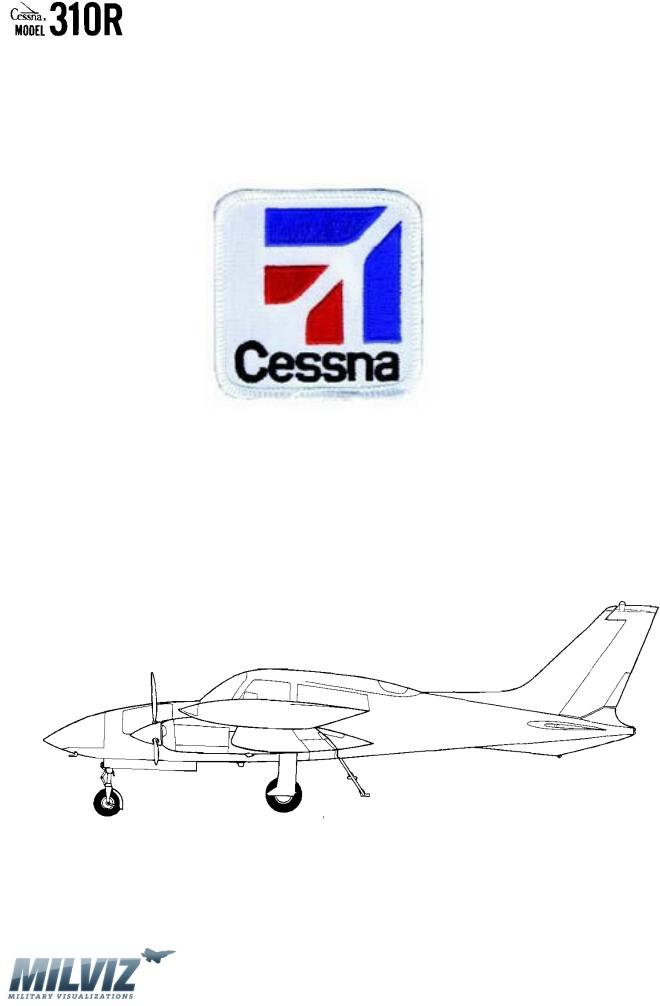
MilViz Cessna 310R Pilot’s Operating Handbook
Military Visualizations Cessna 310R
Pilot’s Operating Handbook
Version 1.0
Version 1.0 – 23 May 2010
[1]

MilViz Cessna 310R Pilot’s Operating Handbook
CONGRATULATIONS
Welcome to the ranks of Cessna owners! Your Cessna has been designed and constructed to give you the most in performance, economy, and comfort. It is our desire that you will find flying it, either for business or pleasure, a pleasant and profitable experience.
This Pilot’s Operating Handbook has been prepared as a guide to help you get the most pleasure and utility from your airplane. It contains information about your Cessna’s equipment, operating procedures, and performance; and suggestions for its servicing and care. We urge you to read it from cover to cover, and to refer to it frequently.
Our interest in your flying pleasure has not ceased with your purchase of a Cessna. Worldwide, the Military Visualizations staff stands ready to serve you. The following services are offered:
MIVIZ Forums: Available 24/7 for technical support, product updates and other announcements.
Email contacts to MILVIZ staff for detailed questions, suggestions, and concerns.
Secure transactions to protect your financial interests.
Version 1.0 – 23 May 2010
[2]

MilViz Cessna 310R Pilot’s Operating Handbook
PERFORMANCE AND SPECIFICATIONS
MAXIMUM WEIGHT: |
|
|
|
|
|
|
Ramp |
…………………………………….……………………………………..………………………………………………….. |
5535 Pounds |
||||
Takeoff ……………………………………………………………….……………………………………………………………… |
5500 Pounds |
|||||
Landing ……………………………………………………………….……………………………………………………………… 5400 Pounds |
||||||
Zero Fuel ………………………………………………………….…………………………….………………………………… |
4900 Pounds |
|||||
*SPEED, BEST POWER MIXTURE: |
|
|
|
|
|
|
Maximum – Sea Level …………………………………………….………………………………………………………..……. |
207 KTAS |
|||||
Maximum Recommended Cruise |
|
|
|
|
|
|
|
75% Power at 7500 Feet |
….………………………………..………………………………….…………………. |
195 KTAS |
|||
*RANGE, RECOMMENDED LEAN MIXTURE: |
|
|
|
|
|
|
Maximum Recommended Cruise |
|
|
|
|
|
|
|
75% Power at 7500 Feet |
…………………………………………………………………..………. 494 Nautical Miles, |
||||
|
(600 Pounds Usable Fuel) |
|
2.62 Hours and 193 KTAS |
|||
|
75% Power at 7500 Feet |
………………………………………………………..…………………. 884 Nautical Miles, |
||||
|
(978 Pounds Usable Fuel) |
|
4.63 Hours and 193 KTAS |
|||
|
75% Power at 7500 Feet |
…………………………………………………………………………. |
1132 Nautical Miles, |
|||
|
(1218 Pounds Usable Fuel) |
5.91 Hours and 194 KTAS |
||||
Maximum Range |
|
|
|
|
|
|
|
10,000 Feet (600 Pounds Usable Fuel) |
……………………………………..……………… 616 Nautical Miles, |
||||
|
|
|
4.12 Hours and 148 KTAS |
|||
|
10,000 Feet (978 Pounds Usable Fuel) |
………………………….……………….………. |
1152 Nautical Miles, |
|||
|
|
|
7.87 Hours and 145 KTAS |
|||
|
10,000 Feet (1218 Pounds Usable Fuel) |
……………………….……………….………. |
1511 Nautical Miles, |
|||
|
|
|
10.46 Hours and 144 KTAS |
|||
RATE-OF-CLIMB AT SEAL LEVEL: |
|
|
|
|
|
|
All Engines ……………………………………………………………………………………..…………………… |
1662 Feet Per Minute |
|||||
One Engine Inoperative ………………………………………………………………………………………… |
370 Feet Per Minute |
|||||
SERVICE CEILING: |
|
|
|
|
|
|
All Engines ……………………………………………………………………………………………………………………….... |
19,750 Feet |
|||||
One Engine Inoperative ………………………………………………………………………………………………………… |
7400 Feet |
|||||
TAKEOFF PERFORMANCE: (82 KIAS, 15o Wing Flaps and 5500 Pounds Weight) |
|
|
|
|||
Ground Roll …………………………………………………………………………………………………………………………… |
1335 Feet |
|||||
Total Distance (Over 50-Foot Obstacle) ………………………………………………………………………..………. |
1700 Feet |
|||||
LANDING PERFORMANCE: (93 KIAS, 35o Wing Flaps and 5400 Pounds Weight) |
|
|
|
|||
Ground Roll ……………………………………………………………………………………………..…………………………….. |
640 Feet |
|||||
Total Distance (Over 50-Foot Obstacle) ………………………………………………………………………………… |
1790 Feet |
|||||
STANDARD EMPTY WEIGHTS: (Approximate) |
|
|
|
|
||
310R |
……………..…………………………………………………………………………………………………….…………… |
3347 Pounds |
||||
310R II |
……………………………………………………………………………………………………………………….…….. |
3589 Pounds |
||||
BAGGAGE ALLOWANCE: ………………………………………………………………………………………………………….………. 950 Pounds WING LOADING: …………………………………………………………………………………………………. 30.73 Pounds Per Square Foot POWER LOADING: ……………………………………………………………………………………..…………. 9.65 Pounds Per Horsepower
Version 1.0 – 23 May 2010
[3]

MilViz Cessna 310R Pilot’s Operating Handbook
FUEL CAPACITY: (Total) |
|
|
Standard (100 Gallons Usable) …………………………………………………………………………….…………….. |
102 Gallons |
|
With Auxiliary Tanks (40 Gallons Usable) |
……………..…………………………………….………… |
143 Gallons |
With Auxiliary Tanks (63 Gallons Usable) |
……………..…………………………………….………… |
166 Gallons |
With Auxiliary Tanks (63 Gallons Usable) and Wing Locker Tanks ..…………….………… |
207 Gallons |
|
OIL CAPACITY: (Total) …………………………………………………………………………………………………………….………….. |
25 Quarts |
|
ENGINES: |
|
|
Six-Cylinder, Fuel-Injected Engines ………………………………………………………………………………..……… |
IO-520-M |
|
285 Rated Horsepower At 2700 Propeller RPM |
|
|
PROPELLERS:
Constant Speed, Full Feathering, Three-Bladed 6’ 4.5” Diameter …………………………………….. 0850334-26
NOTE: Range data includes allowance for start, taxi, takeoff, climb, descent, and 45-minute reserve at 45% power.
*Speeds based on Estimated Mid-Cruise Weight.
Version 1.0 – 23 May 2010
[4]
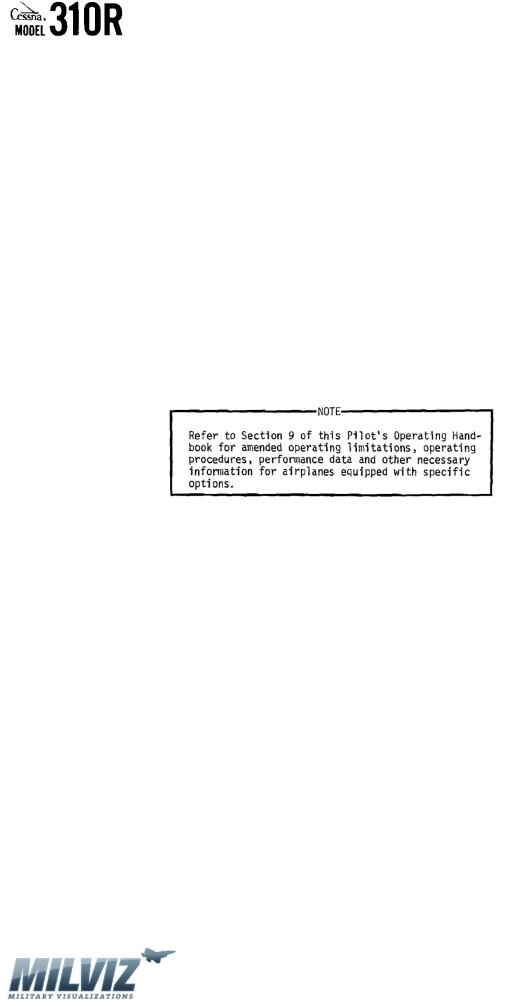
MilViz Cessna 310R Pilot’s Operating Handbook
SECTION 2
LIMITATIONS
TABLE OF CONTENTS
INTRODUCTION …………………….…. 5 AIRSPEED LIMITATIONS …………... 6 ENGINE LIMITATIONS ………………. 7 WEIGHT LIMITS ……………………….. 9 MANEUVER LIMITS ………………….. 10
FLIGHT LOAD FACTOR LIMITS …… |
10 |
|
FLIGHT CREW LIMITS …………………. 10 |
||
OPERATION LIMITS |
…………………… |
10 |
FUEL LIMITATIONS |
……………………. |
11 |
INTRODUCTION
Section 2 of the Pilot’s Operating Handbook presents the operating limitations, the significance of such limitations, instrument markings, color coding, and basic placards necessary for the safe operation of the airplane, its powerplants, standard systems, and standard equipment.
Version 1.0 – 23 May 2010
[5]
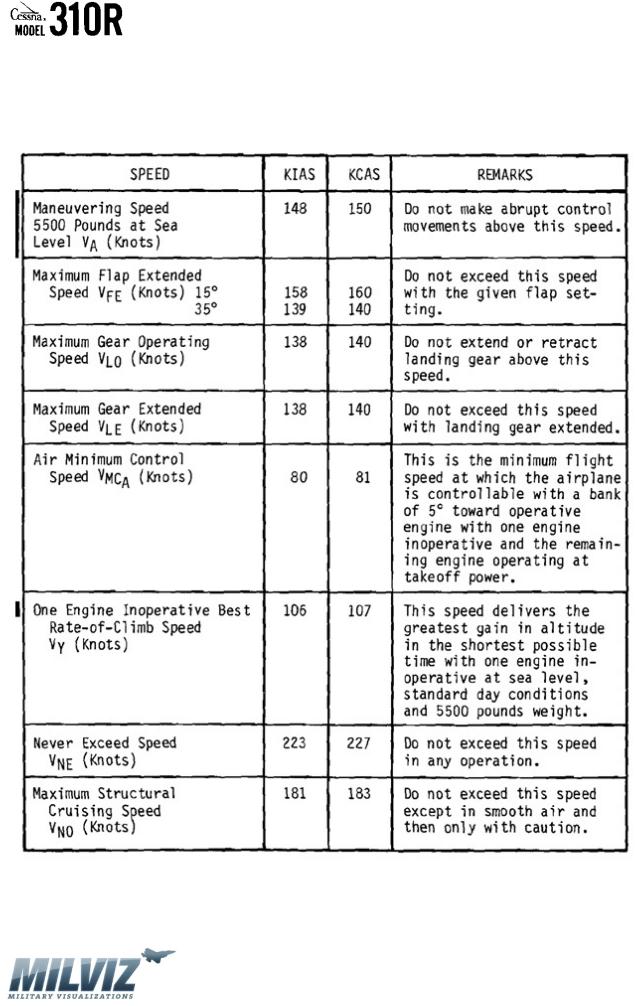
MilViz Cessna 310R Pilot’s Operating Handbook
AIRSPEED LIMITATIONS (See Figure 2-1)
AIRSPEED LIMITATIONS TABLE
Figure 2-1
Version 1.0 – 23 May 2010
[6]
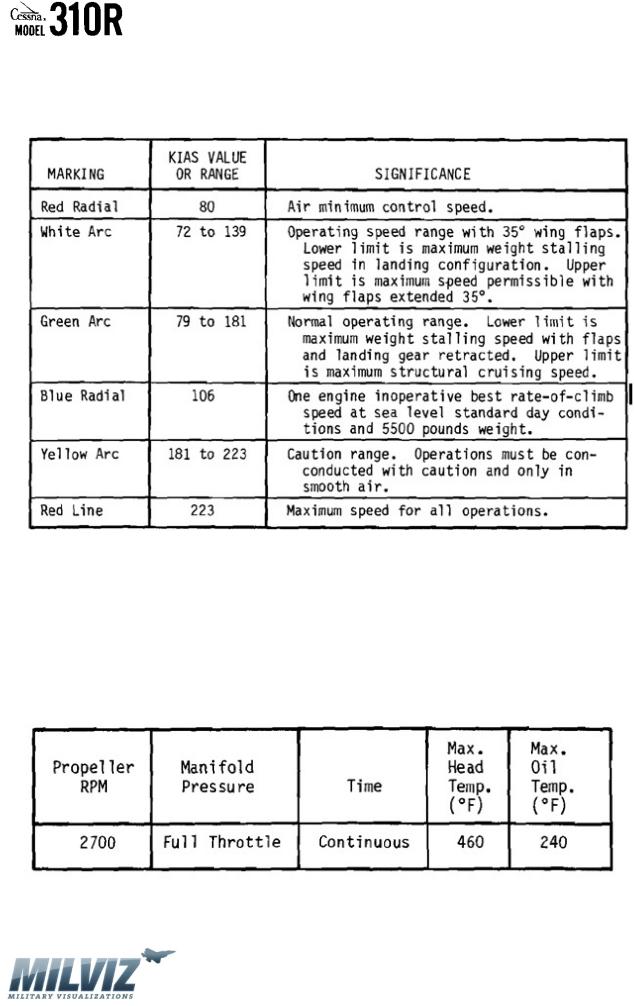
MilViz Cessna 310R Pilot’s Operating Handbook
AIRSPEED INDICATOR TABLE
Figure 2-2
ENGINE LIMITATIONS
Number of Engines: 2
Engine Manufacturer: Teledyne Continenal Motors
Engine Model Number: IO-520-M
Engine Operating Limits for Takeoff and Continuous Operation:
a. Maximum power for all operations (All Altitudes)
Version 1.0 – 23 May 2010
[7]
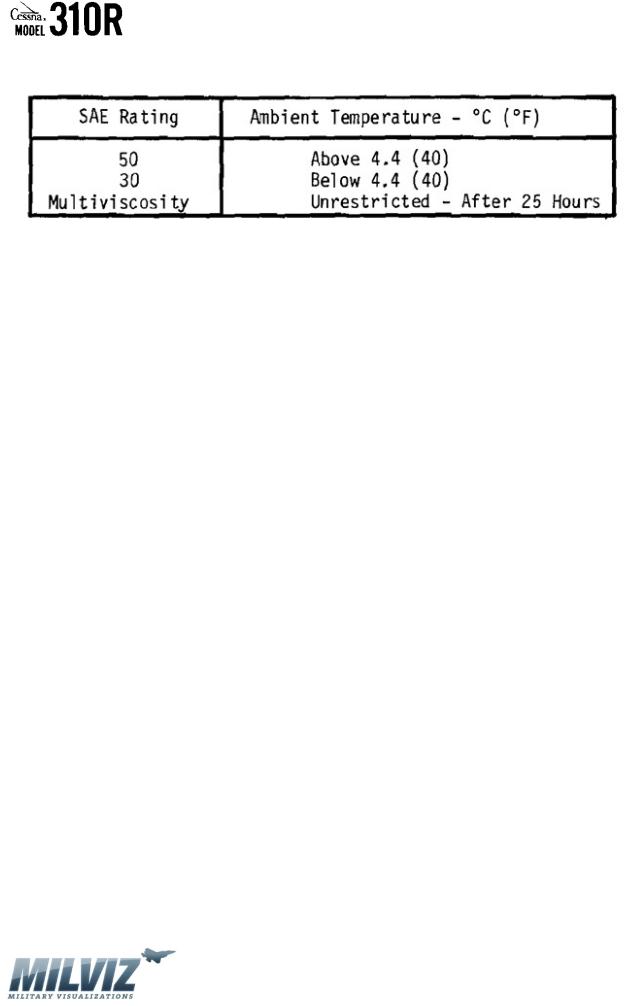
MilViz Cessna 310R Pilot’s Operating Handbook
Oil Viscosity:
Propellers:
a.Number of Propellers: 2
b.Manufacturer: McCauley Accessory Division, Cessna Aircraft Company
c.Part Number: 0850334-26
d.Number of Blades: 3
e.Diameter: 6’ 4.5”
f.Blade Range: (At 30-Inch Station)
(1)Low Pitch 13.9o +/-0.2o
(2)Feather 81.7o +/-0.3o
g.Operating Limits: 2700 RPM maximum speed
Engine Instrument Markings:
a.Tachometer:
(1)Normal Operating 2100 to 2500 RPM (Green Arc)
(2)Maximum 2700 RPM (Red Radial)
b.Manifold Pressure:
(1)Normal Operating 15.0 to 24.5 inches Hg. Manifold Pressure (Green Arc)
c.Oil Temperature:
(1)Normal Operating 75 to 240oF (Green Arc)
(2)Maximum 240oF (Red Radial)
d.Oil Pressure:
(1)Minimum Operating 10 PSI (Red Radial)
(2)Normal Operating 30 to 60 PSI (Green Arc)
(3)Maximum 100 PSI (Red Radial)
e.Cylinder Head Temperature:
(1)Normal Operating 200 to 460oF (Green Arc)
(2)Maximum 460oF (Red Radial)
Version 1.0 – 23 May 2010
[8]

MilViz Cessna 310R Pilot’s Operating Handbook
f, Fuel Flow:
(1)Minimum Operating 2.5 PSI (Red Radial)
(2)Normal Operating 15.0 to 24.5 inches Hg. Manifold Pressure (Green Arc)
(a) Green Radials |
45% Power – 59.0 Pounds per hour (6.5 PSI) |
|
55% Power – 71.0 Pounds per hour (7.6 PSI) |
|
65% Power – 82.0 Pounds per hour (8.8 PSI) |
|
75% Power – 94.0 Pounds per hour (10.25 PSI) |
(b)Blue Triangle 75% Climb Setting – 107.0 Pounds per hour (12.0 PSI)
(c)White Arc – Sea Level Takeoff and Climb Power Setting 146.5 Pounds per hour (19.7 PSI) to 150.0 Pounds per hour (20.5 PSI)
(d)Blue Radials – Altitude Takeoff Power and Climb Power Setting
2000 Feet – 134.0 Pounds per hour (17.0 PSI)
4000 Feet – 124.0 Pounds per hour (15.0 PSI)
6000 Feet – 116.0 Pounds per hour (13.5 PSI)
(3) Maximum Operating 155.0 Pounds per hour (21.7 PSI) (Red Radial)
WEIGHT LIMITS
Maximum Ramp Weight: 5535 Pounds
Maximum Takeoff Weight: 5500 Pounds
Maximum Landing Weight: 5400 Pounds
Maximum Zero Fuel Weight: 4900 Pounds
Maximum Weights in Baggage Compartments:
a.Left and Right Wing Lockers – 120 pounds each.
b.Nose Bay – 350 pounds less installed optional equipment.
c.Aft Cabin (Station 96) – 200 pounds. Extends from Station 89 to 109.
d.Aft Cabin (Station 124) – 160 pounds (4-Place Seating). Station 109 to 132.
e.Aft Cabin (Station 126) – 160 pounds (6-Place Seating). Station 111 to 132.
Version 1.0 – 23 May 2010
[9]

MilViz Cessna 310R Pilot’s Operating Handbook
MANEUVER LIMITS
This is a normal category airplane. Aerobatic maneuvers, including spins, are prohibited.
FLIGHT LOAD FACTOR LIMITS
The design load factors are 150% of the following, and in all cases the structure exceeds design loads.
At Design Takeoff Weight of 5500 Pounds:
a.Landing gear up, wing flaps 0o +3.80 to -1.52G
b.Landing gear down, wing flaps 35o +2.0G
FLIGHT CREW LIMITS
Minimum Flight Crew for FAR 91 operations is one pilot.
OPERATING LIMITS
The standard airplane is approved for day and night operations under VFR conditions. With the proper optional equipment installed, the airplane is approved for day and night IFR operations and flight into icing conditions as defined by the FAA.
Version 1.0 – 23 May 2010
[10]
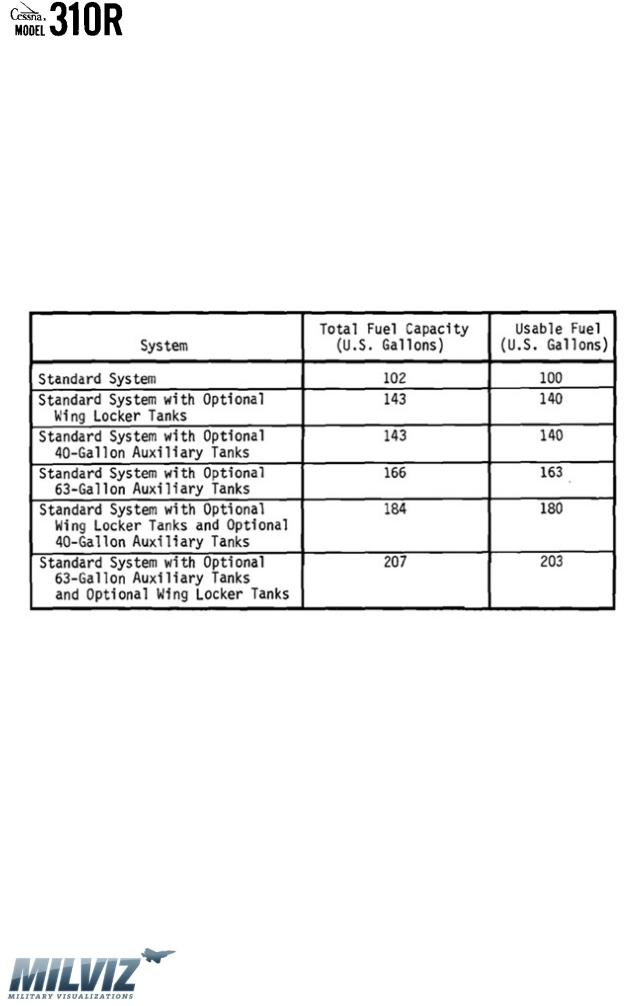
MilViz Cessna 310R Pilot’s Operating Handbook
FUEL LIMITATIONS (See Figure 2-3)
Fuel Pressure:
a.Minimum: 2.5 PSI (0 Pounds Per Hour)
b.Maximum: 21.7 PSI (155.0 Pounds Per Hour) Fuel (Approved Fuel Grades and Colors):
a.100LL Grade Aviation Fuel (Blue).
b.100 (Formerly 100/130) Grade Aviation Fuel (Green).
FUEL TABLE
Figure 2-3
Version 1.0 – 23 May 2010
[11]

MilViz Cessna 310R Pilot’s Operating Handbook
SECTION 3
EMERGENCY PROCEDURES
TABLE OF CONTENTS
INTRODUCTION ……………………………………………………………………………………………………..…. |
12 |
|
EMERGENCY PROCEDURES ABBREVIATED CHECKLISTS ……………………………………….……. |
13 |
|
Engine Inoperative Procedures ………………………………………………………………….…..… |
13 |
|
Fire Procedures ………………………………………………………………………………………...….. |
18 |
|
Emergency Descent Procedures …………………………………………………………..…….….... 19 |
||
Emergency Landing Procedures ………………………………………………………………….…… |
20 |
|
Fuel System Emergency Procedures …………………………………………..……………….…. |
23 |
|
Electrical System Emergency Procedures ……………………………………………………….. |
24 |
|
Avionics Bus Failure ……………………………………………………………………………………...…. 25 |
||
Flight Instruments Emergency Procedures …………………………………………………….. |
25 |
|
Air Inlet or Filter Icing Emergency Procedures …………………………………………….. |
26 |
|
Propeller Synchrophaser |
………………………………………………………………………………. |
26 |
Emergency Exit Window |
………………………………………………………………………………. |
26 |
Spins ……………………………………………………………………………………………………………..…. |
27 |
|
INTRODUCTION
Section 3 of the Pilot’s Operating Handbook describes the recommended procedures for emergency situations. The first part of this section provides emergency procedural action required in an abbreviated checklist form. Amplification of the abbreviated checklist is presented in the second part of this section.
Version 1.0 – 23 May 2010
[12]
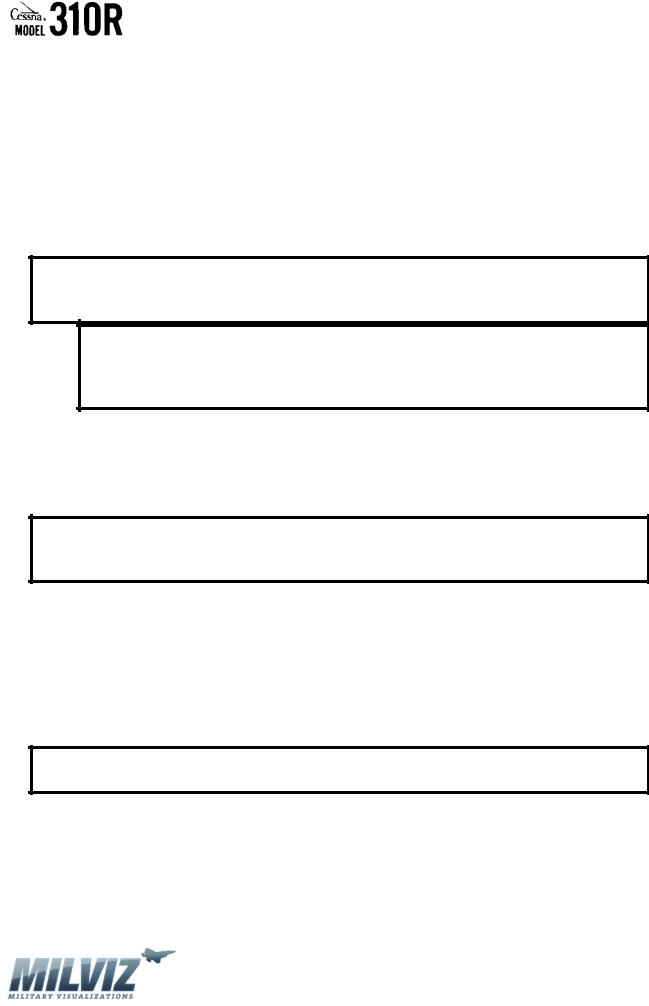
MilViz Cessna 310R Pilot’s Operating Handbook
EMERGENCY PROCEDURES
ABBREVIATED CHECKLISTS
Procedures in the Abbreviated Checklists portion of this section outlined in the black boxes are immediate-action items and should be committed to memory.
AIRSPEEDS FOR SAFE OPERATION
Conditions:
1.Takeoff Weight 5500 Pounds
2.Landing Weight 5400 Pounds
3.Standards Day, Sea Level
a.Air Minimum Control Speed …………………………………………………..….. 80 KIAS
b.Intentional One Engine Inoperative Speed …………………………..……. 92 KIAS
c. One Engine Inoperative Best Angle-of-Climb Speed ………………… 95 KIAS d. One Engine Inoperative Best Rate-of-Climb Speed (Flaps UP) ……. 106 KIAS
ENGINE INOPERATIVE PROCEDURES
ENGINE SECURING PROCEDURES
1.Throttle – CLOSE
2.Propeller – FEATHER
3.Mixture – IDLE CUT-OFF
4.Fuel Selector – OFF
5.Auxiliary Fuel Pump – OFF
6.Magneto Switches – OFF
7.Propeller Synchrophaser – OFF (Optional System)
8.Alternator – OFF
9.Cowl Flap -- CLOSE
ENGINE FAILURE DURING TAKEOFF (Speed Below 92 KIAS)
1.Throttles – CLOSE IMMEDIATELY
2.Brakes – AS REQUIRED
Version 1.0 – 23 May 2010
[13]
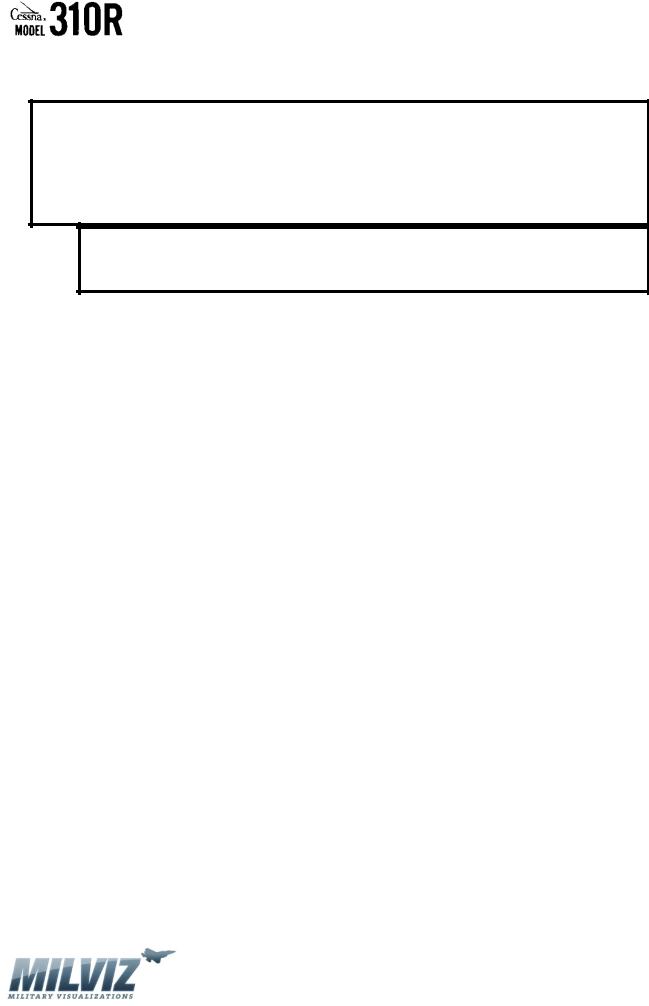
MilViz Cessna 310R Pilot’s Operating Handbook
ENGINE FAILURE AFTER TAKEOFF (Speed Above 92 KIAS With Gear Up Or In Transit)
1.Mixtures – AS REQUIRED for flight altitude
2.Propellers – FULL FORWARD
3.Throttles – FULL FORWARD
4.Flaps – UP if extended, in small increments, RETRACTED on blue line speed
5.Landing Gear – CHECK UP
6.Inoperative Engine – DETERMINE:
a.Identify Failed Engine – FOOT OFF RUDDER on failed engine side
b.Verify Failed Engine – RETARD THROTTLE to confirm no loss of power
c.Feather Failed Engine – SET PROP CONDITION LEVER to feather detent
7.Establish Bank – 6o toward operative engine
8.Climb to Clear 50-Foot Obstacle – 92 KIAS
9.Climb at Best Single-Engine-Rate-of-Climb Speed – 106 KIAS at sea level; 94 KIAS at 10,000 Feet
10.Trim Tabs – ADJUST 5o bank toward operative engine with approximately ½ ball slip indicated on the turn and bank indicator
11.Cowl Flap – Close (Inoperative Engine)
12.Inoperative Engine – SECURE as follows:
a.Fuel Selector – OFF
b.Auxiliary Fuel Pump – OFF
c.Magneto Switches – OFF
d.Alternator – OFF
13.As Soon As Practical – LAND
Version 1.0 – 23 May 2010
[14]
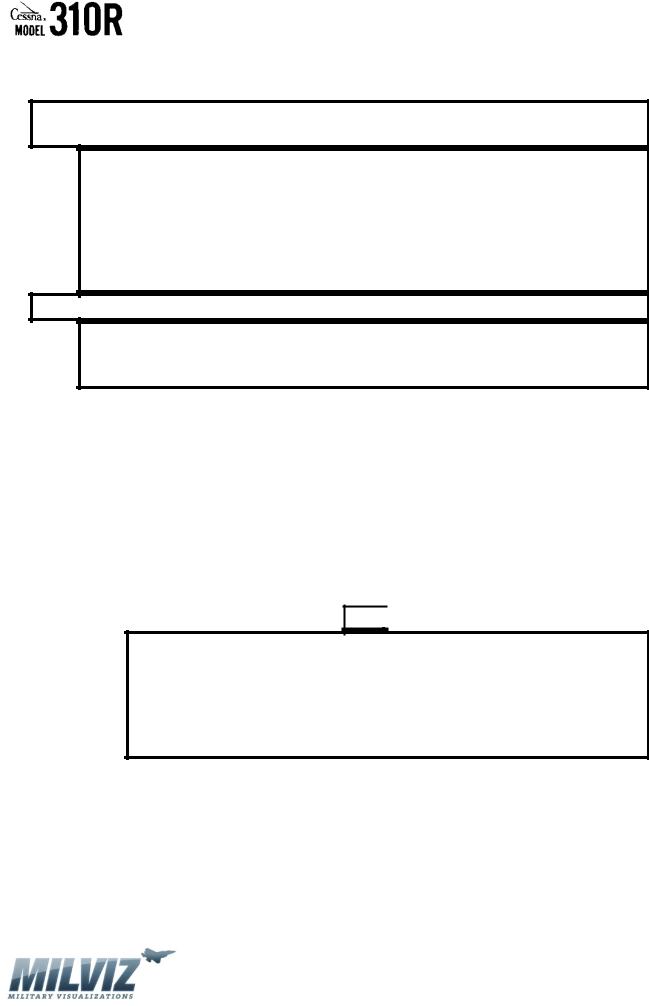
MilViz Cessna 310R Pilot’s Operating Handbook
ENGINE FAILURE DURING FLIGHT
1.Inoperative Engine – DETERMINE, if conditions allow
2.Before Securing Inoperative Engine, if conditions allow:
a.Fuel Flow – CHECK If deficient, position auxiliary fuel pump to ON
b.Fuel Selectors – MAIN TANKS
c.Fuel Quantity – CHECK
d.Oil Pressure and Oil Temperature – CHECK
e.Magneto Switches – CHECK ON
f.Mixture – ADJUST until evidence of engine firing. Continue to adjust for smooth operation
3.Inoperative Engine – SECURE: (Perform immediately if conditions require)
a.Identify Failed Engine – FOOT OFF RUDDER on failed engine side
b.Verify Failed Engine – RETARD THROTTLE to confirm no loss of power
c.Feather Failed Engine – SET PROP CONDITION LEVER to feather detent
d.Mixture – IDLE CUT-OFF
e.Fuel Selector – OFF
f.Auxiliary Fuel Pump – OFF
g.Magneto Switches – OFF
h.Propeller Synchrophaser – OFF
i.Alternator – OFF
j.Cowl Flap -- CLOSE
4.Operative Engine – ADJUST
a.Power – AS REQUIRED
b.Mixture – AS REQUIRED for flight altitude
c.Fuel Selector – AS REQUIRED
NOTE
•Auxiliary Fuel on the side of the failed engine is inaccessible
•Position operative engine fuel selector to MAIN TANK and feel for detent if below 1000 feet AGL or if nearest airport is within range o fuel remaining in MAIN TANK. If necessary, range can be extended by using wing locker fuel, opposite main fuel or auxiliary fuel on the side of the operative engine. Crossfeed as required to maintain lateral balance.
d.Auxiliary Fuel Pump – ON
e.Cowl Flap – AS REQUIRED
5.Trim Tabs – ADJUST 5o bank toward operative engine with approximately ½ ball slip indicated on the turn and bank indicator
6.Electrical Load – DECREASE to minimum required
7.As Soon As Practical -- LAND
Version 1.0 – 23 May 2010
[15]
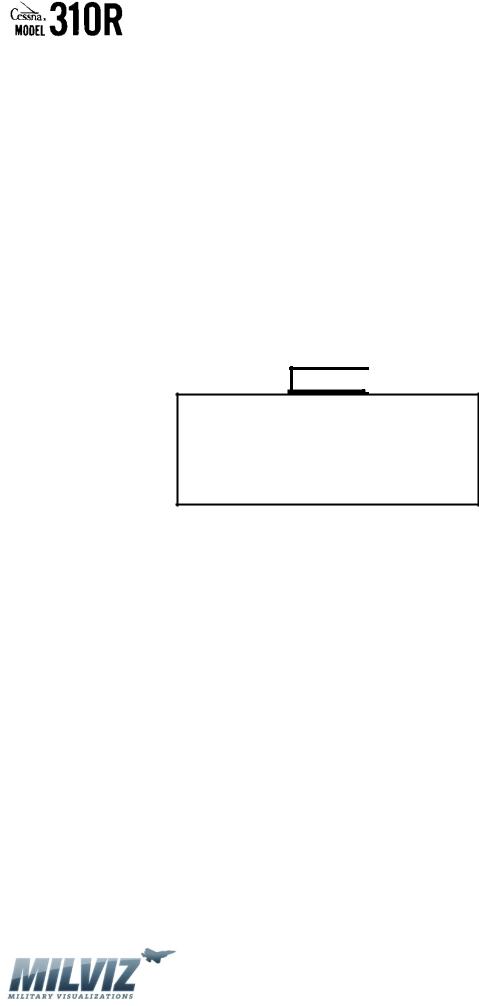
MilViz Cessna 310R Pilot’s Operating Handbook
ENGINE INOPERATIVE LANDING
1.Fuel Selector – MAIN TANK
2.Auxiliary Fuel Pump – ON (Operative Engine)
3.Alternate Air Control – IN
4.Mixture – AS REQUIRED for flight altitude
5.Propeller Synchrophaser – OFF (Optional System)
6.Propeller – FULL FORWARD
7.Approach – 106 KIAS with excessive altitude
8.Landing Gear – DOWN within gliding distance of field
9.Wing Flaps – DOWN when landing is assured
10.Speed – DECREASE below 93 KIAS only if landing is assured
11.Air Minimum Control Speed – 80 KIAS
ENGINE INOPERATIVE GO-AROUND (Speed Above 92 KIAS)
WARNING
Level flight may not be possible for certain combinations of weight, temperature and altitude. In any event, do not attempt an engine inoperative go-around after wing flaps have been extended beyond 15o
1.Throttle – FULL FORWARD
2.Mixture – AS REQUIRED for flight altitude
3.Positive Rate-of-Climb – ESTABLISH
4.Landing Gear – UP
5.Wing Flaps – UP, if extended
6.Cowl Flaps – OPEN
7.Climb at Best Single-Engine Rate-of-Climb Speed – 106 KIAS at sea level; 94 KIAS at 10,000 feet
8.Trim Tabs – ADJUST 5o bank toward operative engine with approximately ½ ball slip indicated on the turn and bank indicator
Version 1.0 – 23 May 2010
[16]
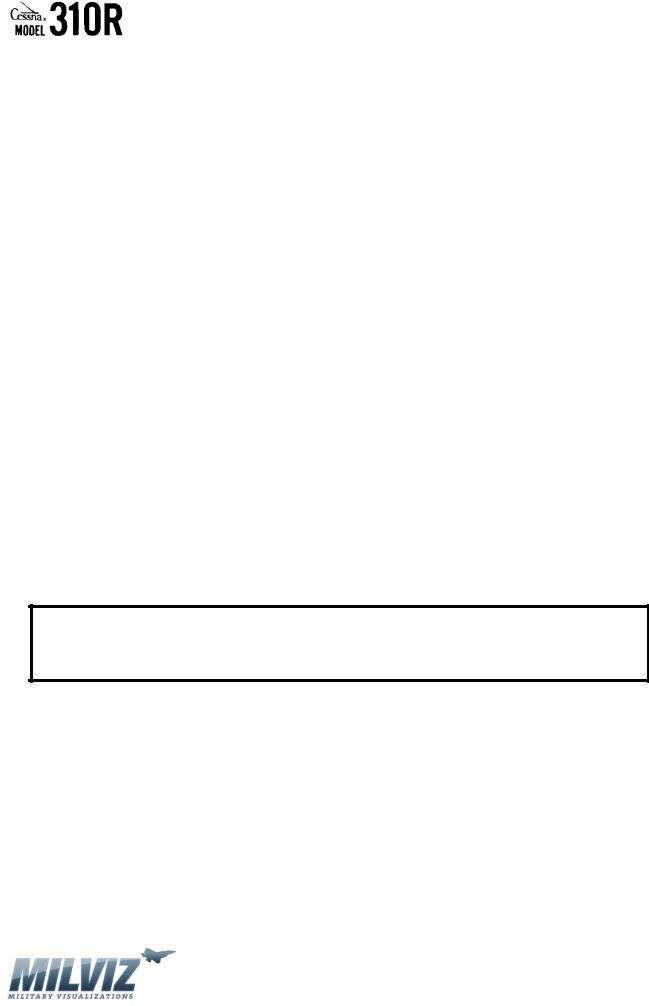
MilViz Cessna 310R Pilot’s Operating Handbook
AIRSTART
Airplane Without Optional Propeller Unfeathering System:
1.Auxiliary Fuel Pump – CHECK OFF If ON or LOW, purge engine by turning OFF auxiliary fuel pump, mixture to IDLE CUT-OFF, throttle full open, magneto switches OFF, and rotating engine 15 revolutions with starter.
2.Magneto Switches – ON
3.Fuel Selector – MAIN TANK
4.Throttle – FORWARD approximately one inch
5.Mixture – AS REQUIRED for flight altitude
6.Propeller – FORWARD of detent
7.Starter Button – PRESS
8.Primer Switch – ACTIVATE in direction of engine to start
9.Starter and Primer Switch – RELEASE when engine fires
10.Auxiliary Fuel Pump – LOW
11.Mixture – AS REQUIRED
12.Power – INCREASE after cylinder head temperature reaches 200oF with gradual mixture enrichment as power increases
13.Cowl Flap – AS REQUIRED
14.Alternator – ON
BOTH ENGINES FAILURE DURING CRUISE FLIGHT
1.Wing Flaps – UP
2.Landing Gear – UP
3.Propellers – FEATHER
4.Cowl Flaps – CLOSE
5.Airspeed – 111 KIAS
6.Landing – Refer to FORCED LANDING (Complete Power Loss) in this section
Version 1.0 – 23 May 2010
[17]
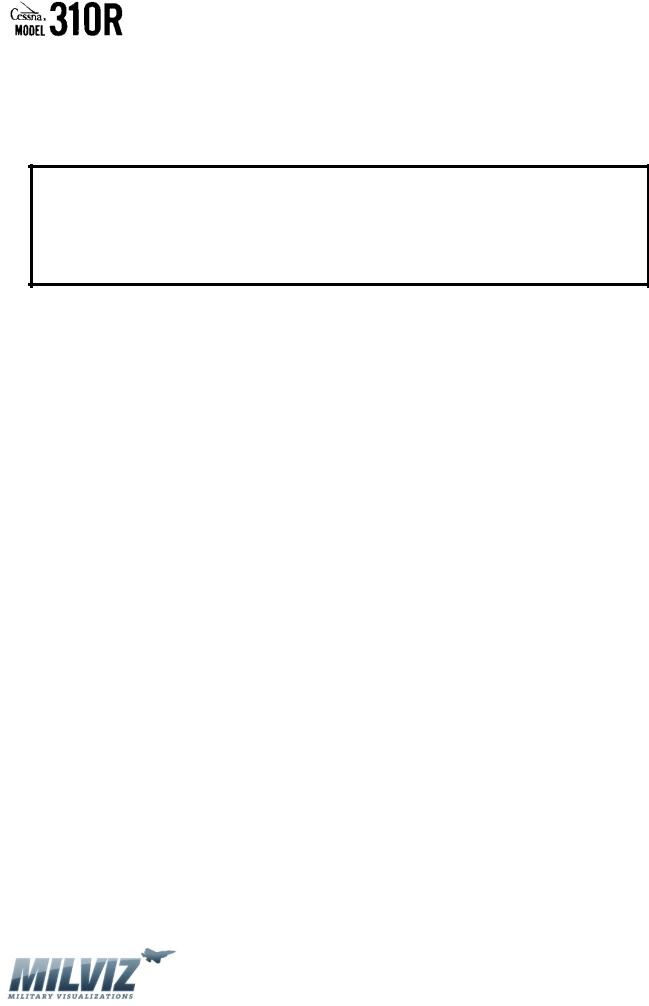
MilViz Cessna 310R Pilot’s Operating Handbook
FIRE PROCEDURES
FIRE ON THE GROUND (Engine Start, Taxi And Takeoff With Sufficient Distance Remaining To Stop)
1.Throttles – CLOSE
2.Brakes – AS REQUIRED
3.Mixtures – IDLE CUT-OFF
4.Battery – OFF (Use Gang Bar)
5.Magnetos – OFF (Use Gang Bar)
6.Evacuate airplane as soon as practical
INFLIGHT WING OR ENGINE FIRE
1.Both Auxiliary Fuel Pumps – OFF
2.Appropriate Engine – SECURE
a.Throttle – CLOSE
b.Propeller – FEATHER
c.Mixture – IDLE CUT-OFF
d.Fuel Selector – OFF
e.Cowl Flap – CLOSE
f.Magnetos – OFF
g.Propeller Synchrophaser – OFF (Optional System)
h.Alternator – OFF
3.Cabin Heater – OFF
4.Land and evacuate airplane as soon as practical
Version 1.0 – 23 May 2010
[18]
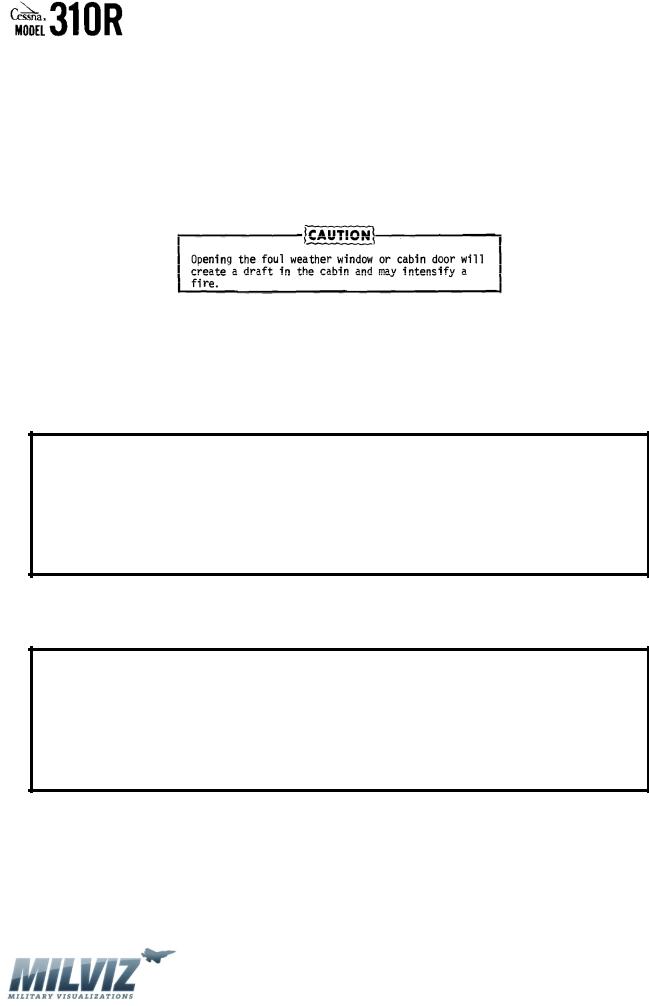
MilViz Cessna 310R Pilot’s Operating Handbook
INFLIGHT CABIN FIRE OR SMOKE
1.Electrical Load – REDUCE to minimum required
2.Attempt to isolate the source of fire or smoke
3.Wemacs – OPEN
4.Cabin Air Controls – OPEN all vents including windshield defrost; CLOSE if intensity of smoke increases
5.Land and evacuate airplane as soon as practical
EMERGENCY DESCENT PROCEDURES
PREFERRED PROCEDURE
1.Throttle – IDLE
2.Propellers – FULL FORWARD
3.Mixtures – ADJUST for smooth operation with gradual enrichment as altitude is lost
4.Wing Flaps – UP
5.Landing Gear – UP
6.Moderate Bank – INITIATE
7.Airspeed – 220 KIAS
IN TURBULENT ATMOSPHERIC CONDITIONS
1.Throttles – IDLE
2.Propellers – FULL FORWARD
3.Mixtures – ADJUST for smooth operation with gradual enrichment as altitude is lost
4.Wing Flaps – DOWN 35o
5.Landing Gear – DOWN
6.Moderate Bank – INITIATE
7.Airspeed – 138 KIAS
Version 1.0 – 23 May 2010
[19]

MilViz Cessna 310R Pilot’s Operating Handbook
EMERGENCY LANDING PROCEDURES
FORCED LANDING (With Power)
1.Landing Site – CHECK (Overfly site at 100 KIAS and 15o wing flaps)
2.Landing Gear – DOWN if surface is smooth and hard
a.Normal Landing – INITIATE (Keep nosewheel off ground as long as practical)
3.Landing Gear – UP if surface is rough or soft
a.Approach – 100 KIAS with 15o wing flaps
b.All Switches Except Magnetos – OFF
c.Cabin Door – UNLATCH prior to flare-out
d.Mixtures – IDLE CUT-OFF
e.Magneto Switches – OFF
f.Fuel Selectors – OFF
g.Landing Attitude – NOSE HIGH
FORCED LANDING (Complete Power Loss)
1.Mixtures – IDLE CUT-OFF
2.Propellers – FEATHER
3.Fuel Selectors – OFF
4.All Switches Except Battery – OFF
5.Approach – 111 KIAS
6.If Smooth and Hard Surface:
a.Landing Gear – DOWN within gliding distance of field
b.Wing Flaps – AS REQUIRED
c.Battery Switch – OFF
d.Cabin Door – UNLATCH prior to flare-out
e.Normal Landing – INITIATE (Keep nosewheel off ground as long as practical)
7.If Rough or Soft Surface:
a.Landing Gear – UP
b.Wing Flaps – DOWN 15o
c.Approach – 97 KIAS
d.Battery Switch – OFF
e.Cabin Door – UNLATCH prior to flare-out
f.Landing Attitude – NOSE HIGH
Version 1.0 – 23 May 2010
[20]

MilViz Cessna 310R Pilot’s Operating Handbook
LANDING WITH FLAT MAIN GEAR TIRE
1.Landing Gear – Leave DOWN
2.Fuel Selectors – SELECT main tank on same side as defective tire
3.Fuel Selectors – MAIN TANKS
4.Wind should be headwind or crosswind opposite the defective tire
5.Wing Flaps – DOWN 35o
6.In approach, align airplane with edge of runway opposite the defective tire, allowing room for a mild turn in the landing roll
7.Land slightly wing low on the side of the inflated tire and lower the nosewheel to the ground immediately for a positive steering
8.Use full aileron in landing roll to lighten the load on the defective tire
9.Apply brakes only on the inflated tire to minimize landing roll and maintain directional control
10.Stop airplane to avoid further damage unless active runway must be cleared for other traffic
LANDING WITH DEFECTIVE MAIN GEAR
1.Fuel Selectors – SELECT main tank on the same side as defective gear
2.Fuel Selectors – MAIN TANKS before landing
3.Wind – HEADWIND or crosswind opposite defective gear
4.Landing Gear – DOWN
5.Wing Flaps – DOWN 35o
6.Approach – ALIGN AIRPLANE with the edge of runway opposite the defective landing gear
7.Battery Switch – OFF
8.Land wing low toward operative landing gear. Lower nosewheel immediately for positive steering
9.Ground Loop – INITIATE into defective landing gear
10.Mixtures – IDLE CUT-OFF
11.Use full aileron in landing roll to lighten the load on the defective gear
12.Apply brakes only on the operative landing gear to hold desired rate of turn and shorten landing roll
13.Fuel Selectors – OFF
14.Airplane – EVACUATE
Version 1.0 – 23 May 2010
[21]

MilViz Cessna 310R Pilot’s Operating Handbook
LANDING WITH FLAT NOSE GEAR TIRE
1.Landing Gear – Leave DOWN
2.Passengers and Baggage – MOVE AFT
3.Approach – 100 KIAS with 15o Wing Flaps
4.Landing Attitude – NOSE HIGH
5.Nose – HOLD OFF during landing roll
6.Brakes – MINIMUM in landing roll
7.Throttles – RETARD in landing roll
8.Control Wheel – FULL AFT until airplane stops
9.Minimize additional taxiing to prevent further damage
LANDING WITH DEFECTIVE NOSE GEAR
1.If Smooth and Hard Surface:
a.Baggage and Passengers – MOVE AFT
b.Landing Gear – DOWN
c.Approach – 100 KIAS with 15o Wing Flaps
d.Landing Attitude – NOSE HIGH
e.Nose – HOLD OFF during landing roll
f.Brakes – MINIMUM in landing roll
g.Throttles – RETARD in landing roll
h.Control Wheel – FULL AFT until airplane stops
i.Minimize additional taxiing to prevent further damage
2.If Rough or Sod Surface:
a.Landing Gear – UP
b.Approach – 100 KIAS with 15o Wing Flaps
c.All Switches Except Magnetos – OFF
d.Cabin Doors – UNLATCH prior to flare-out
e.Landing Attitude – NOSE HIGH
f.Mixtures – IDLE CUT-OFF
g.Magnetos Switches – OFF
h.Fuel Selectors – OFF
Version 1.0 – 23 May 2010
[22]

MilViz Cessna 310R Pilot’s Operating Handbook
LANDING WITHOUT FLAPS (0o Extension)
1.Mixtures – AS REQUIRED for flight altitude
2.Propellers – FULL FORWARD
3.Fuel Selectors – MAIN TANKS
4.Minimum Approach Speed – 105 KIAS
5.Landing Gear – DOWN
DITCHING
1.Landing Gear – UP
2.Approach – HEADWIND if high winds; PARALLEL to SWELLS if light wind and heavy swells
3.Wing Flaps – DOWN 35o
4.Power – AS REQUIRED (300 Feet Per Minute Descent)
5.Airspeed – 93 KIAS minimum
6.Attitude – DESCENT ATTITUDE through touchdown
FUEL SYSTEM EMERGENCY PROCEDURES
ENGINE-DRIVEN FUEL PUMP FAILURE
1.Fuel Selector – MAIN TANK
2.Auxiliary Fuel Pump – ON
3.Cowl Flap – OPEN
4.Mixture – ADJUST for smooth engine operation
5.As Soon As Practical – LAND
6.Fuel in the auxiliary and opposite main tank is unusable
Version 1.0 – 23 May 2010
[23]

MilViz Cessna 310R Pilot’s Operating Handbook
ELECTRICAL SYSTEM EMERGENCY PROCEDURES
ALTERNATOR FAILURE (Single)
1.Electrical Load – REDUCE
2.If Circuit Breaker Is Tripped:
a.Turn off affected alternator
b.Reset affected alternator circuit breaker
c.Turn on affected alternator switch
d.If circuit breaker reopens, turn off alternator
3.If Circuit Breaker Does Not Trip:
a.Select affected alternator on voltmeter and monitor output
b.If output is normal and failure light remains on, disregard fail indication and have indicator checked after landing
c.If output is insufficient, turn off alternator and reduce electrical load to one alternator capacity
d.If complete loss of alternator output occurs, check field fuse and replace if necessary
e.If an intermittent light indication accompanied by voltmeter fluctuation is observed, turn off affected alternator and reduce load to one alternator capacity
Version 1.0 – 23 May 2010
[24]

MilViz Cessna 310R Pilot’s Operating Handbook
ALTERNATOR FAILURE (Dual)
1.Electrical Load – REDUCE
2.If Circuit Breakers Are Tripped:
a.Turn off alternators
b.Reset circuit breakers
c.Turn on left alternator and monitor output on voltmeter
d.If alternator is charging, leave it on. Disregard failure light if still illuminated
e.If still inoperative, turn off left alternator
f.Repeat steps c through e for right alternator
g.If circuit breakers reopen, prepare to terminate flight
3.If Circuit Breakers Have Not Tripped:
a.Turn off alternators
b.Check field fuses and replace as required
c.Turn on left alternator and monitor output on voltmeter
d.If alternator is charging, leave it on. Disregard failure light if still illuminated
e.If still inoperative, turn off left alternator
f.Repeat steps c through e for right alternator
g.If both still inoperative, turn off alternators and turn on emergency alternator field switch
h.Repeat steps c through e for each alternator
i.If still inoperative, turn off alternators, nonessential electrical items and prepare to terminate flight
AVIONICS BUS FAILURE
1.Avionics Master Switch – OFF
2.Emergency Avionics Power Switch – ON
FLIGHT INSTRUMENTS EMERGENCY PROCEDURES
VACUUM PUMP FAILURE (Attitude and Directional Gyros)
1.Failure indicated by left or right red failure button exposed on vacuum pump gage
2.Automatic valve will select operative source
3.Vacuum Pressure – CHECK proper vacuum from operative source
Version 1.0 – 23 May 2010
[25]
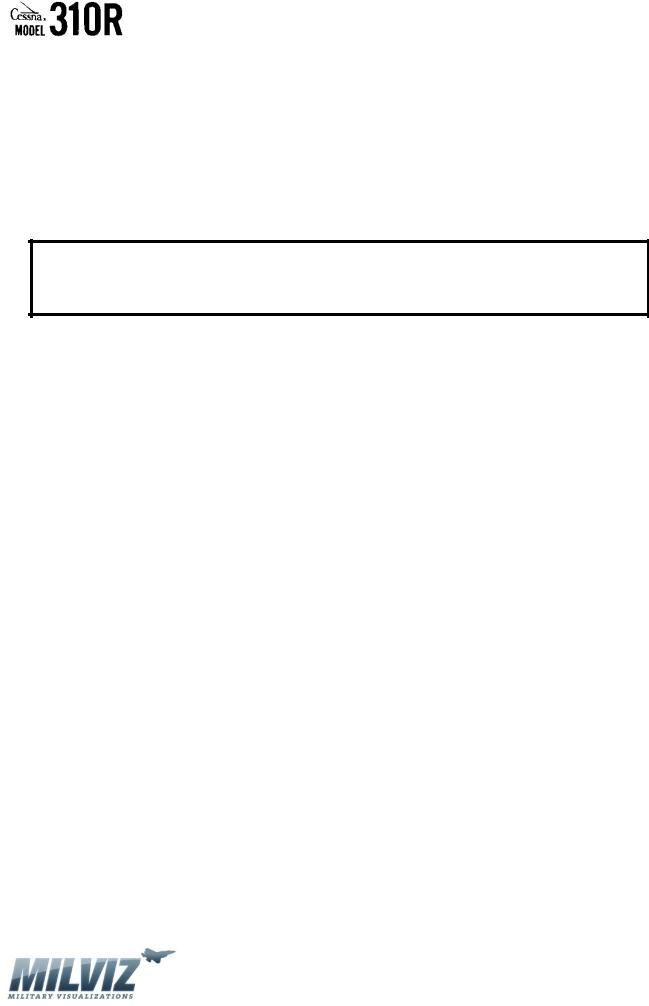
MilViz Cessna 310R Pilot’s Operating Handbook
OBSTRUCTION OR ICING OF STATIC SOURCE
1.Alternate Static Source – OPEN
2.Excess Altitude and Airspeed – MAINTAIN to compensate for change in calibration
AIR INLET OR FILTER ICING EMERGENCY PROCEDURES
1.Alternate Air Control(s) – PULL OUT
2.Power – INCREASE as required
3.Mixture(s) – LEAN as required
PROPELLER SYNCHROPHASER
ENGINE INOPERATIVE PROCEDURES
1. Propeller Synchrophaser – OFF (Optional System)
SYNCHROPHASER FAILURE
1.Propeller Synchrophaser – OFF (Optional System)
2.Propeller Synchrophaser Circuit Breaker – PULL (Optional System)
EMERGENCY EXIT WINDOW
1.Red Handle – PULL down and to the rear
2.Window – PUSH OUT at top
Version 1.0 – 23 May 2010
[26]
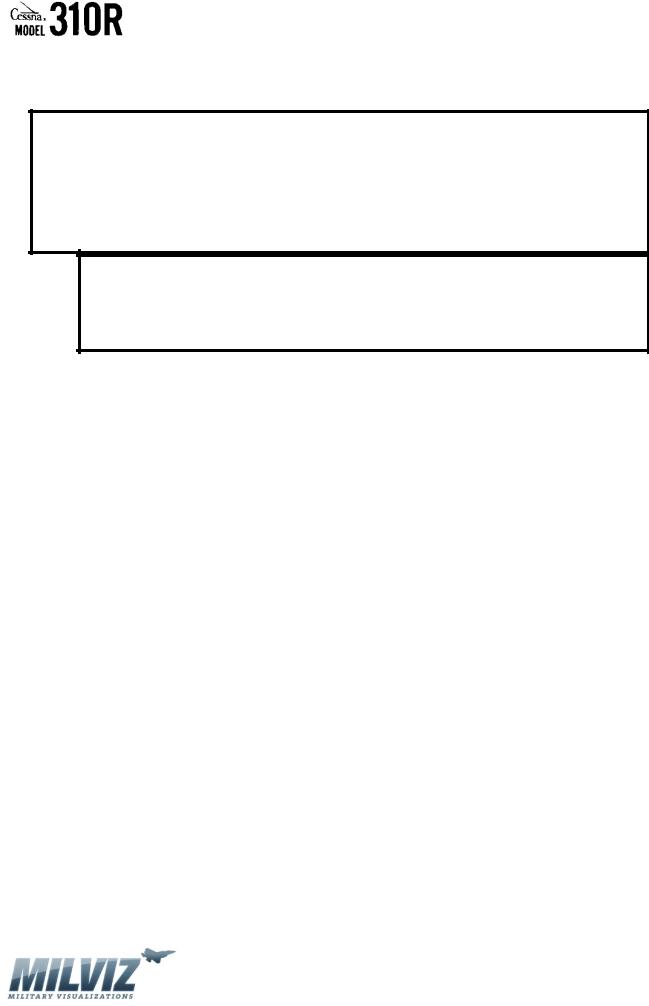
MilViz Cessna 310R Pilot’s Operating Handbook
SPINS
1.Throttles – CLOSE IMMEDIATELY
2.Ailerons – NEUTRALIZE
3.Rudder – HOLD FULL RUDDER opposite the direction of rotation
4.Control Wheel – FORWARD BRISKLY, ½ turn of spin after applying full rudder
5.Inboard Engine – INCREASE POWER to slow rotation (If Necessary)
6.After rotation has stopped:
a.Rudder – NEUTRALIZE
b.Inboard Engine (If Used) – DECREASE POWER to equalize engines
c.Control Wheel – PULL to recover from resultant dive. Apply smooth steady control pressure
Version 1.0 – 23 May 2010
[27]
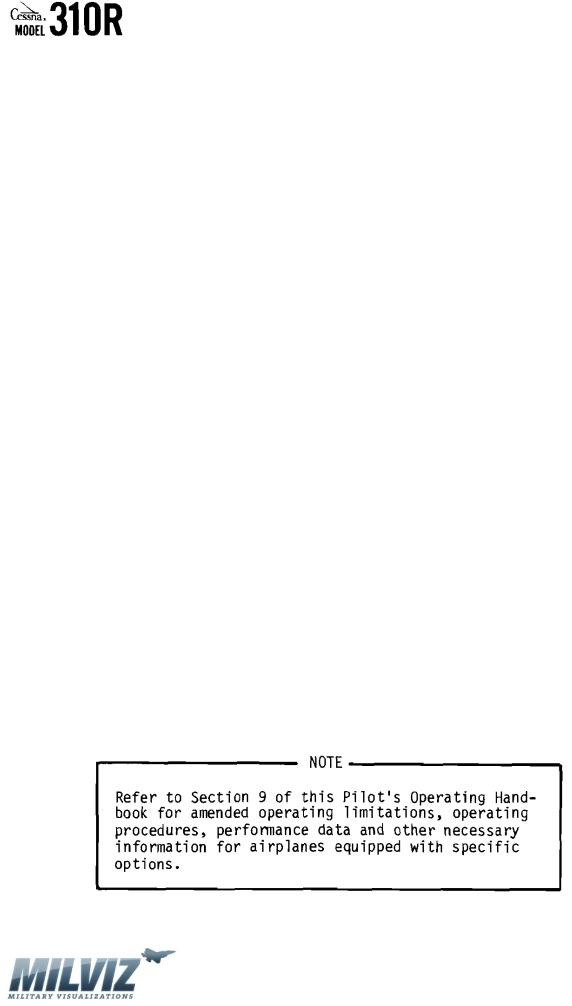
MilViz Cessna 310R Pilot’s Operating Handbook
SECTION 4
NORMAL PROCEDURES
TABLE OF CONTENTS
INTRODUCTION ……………………………………………………………………………………………………… |
28 |
||
Preflight Inspection ……………………………………………………………………….………….… |
29 |
||
NORMAL PROCEDURES AMPLIFIED CHECKLISTS ………………………………..…..……………… |
31 |
||
Airspeeds for Safe Operation ……………………………………………………………………… |
31 |
||
Before Starting Engines ………………………………………………………………………………. |
32 |
||
Starting Engines ………………………………………………………………………………………….. |
33 |
||
Before Taxiing |
…………………………………………………………………………………………….. |
34 |
|
Taxiing |
………………………………………………………………………………………………………… |
34 |
|
Before Takeoff |
…………………………………………………………………………………………….. |
35 |
|
Takeoff |
………………………………………………………………………………………………………… |
36 |
|
After Takeoff |
……………………………………………………………………………………………….. |
38 |
|
Climb |
………………………………………………………………………………………………………….. |
38 |
|
Cruise |
…………………………………………………………………………………………………………. |
39 |
|
Descent ………………………………………………………………………………………………………. |
41 |
||
Before Landing |
…………………………………………………………………………………………… |
41 |
|
Balked Landing |
…………………………………………………………………………………………… |
42 |
|
After Landing |
……………………………………………………………………………………………… |
42 |
|
Shutdown ………………………………………………………………………………………………….. |
43 |
||
INTRODUCTION
Section 4 of the Pilot’s Operating Handbook describes the recommended procedures for normal operations. This section provides normal procedural action required in an abbreviated checklist form.
Version 1.0 – 23 May 2010
[28]
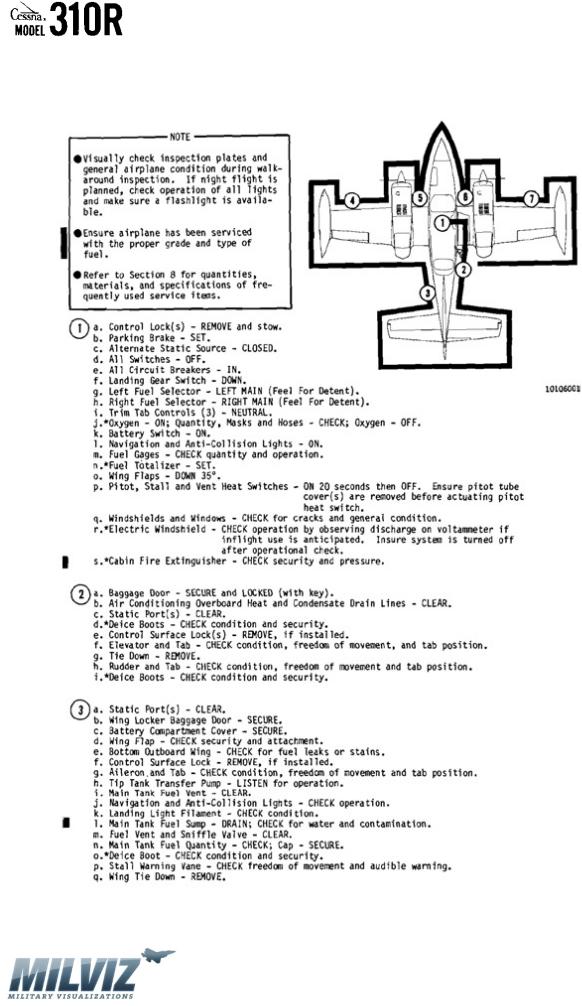
MilViz Cessna 310R Pilot’s Operating Handbook
PREFLIGHT INSPECTION
Version 1.0 – 23 May 2010
[29]
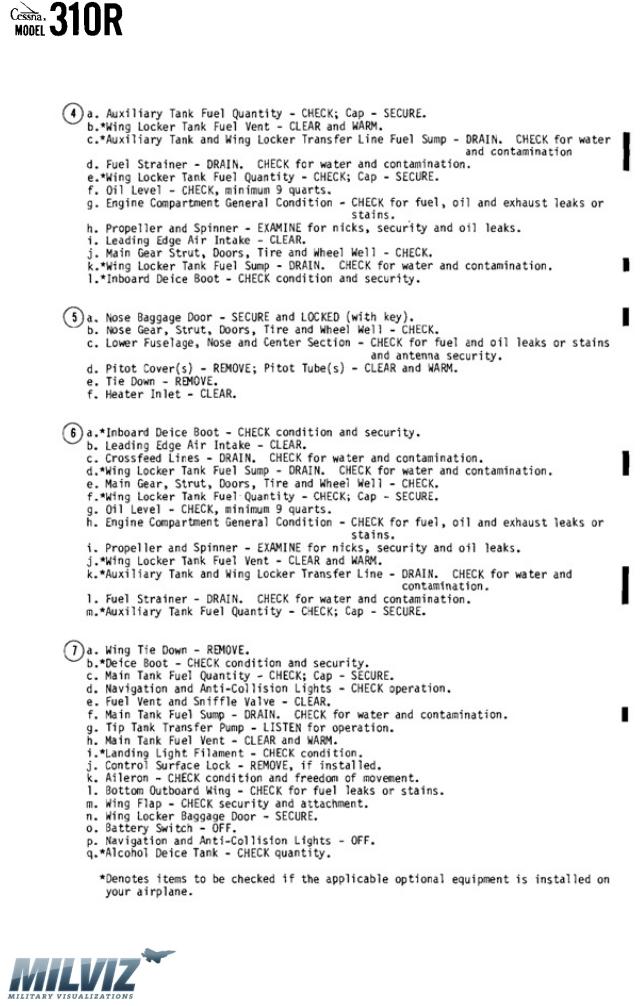
MilViz Cessna 310R Pilot’s Operating Handbook
Version 1.0 – 23 May 2010
[30]
